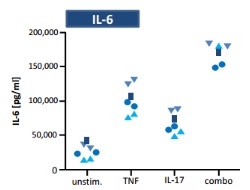Romatoid artritte tedavi için terapötik fırsat olarak TNFα ve IL-17’nin kombine inhibisyonu: Yeni bir bispesifik antikorun geliştirilmesi ve nitelendirilmesi.
Arthritis Rheumatol. 2015;67(1):51–62
To this end, Fischer et al. investigated whether combined inhibition of TNFα and IL-17 has an additive/synergistic effect in the suppression of mesenchymal cell activation in vitro and inflammation and tissue destruction in arthritis in vivo, using mouse models. Their research into the single and combined effects of TNFα and IL-17, in cultures of human fibroblast-like synoviocytes, demonstrated a more effective response in vitro with combined blockade (bi-specific anti-TNFα/IL-17 antibodies), and a positive impact in vivo on rebalance of bone homeostasis. Combined inhibition of these two cytokines may represent a powerful strategy to treat inflammatory arthritis.

